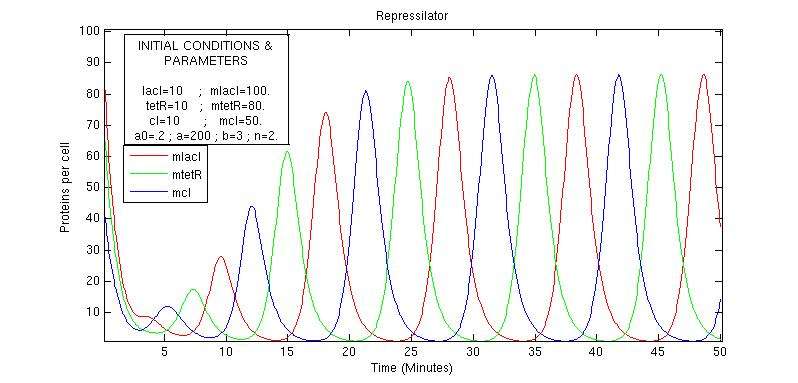Repressilator
The repressilator is a synthetic genetic regulatory network consisting of a ring-oscillator with three genes, each expressing a protein that represses the next gene in the loop.[1]
Discovery
Repressilators were first reported in a paper[2] by Michael Elowitz and Stanislas Leibler in 2000. This network was designed from scratch to exhibit a stable oscillation which is reported via the expression of green fluorescent protein, and hence acts like an electrical oscillator system with fixed time periods. The network was implemented in Escherichia coli using standard molecular biology methods and observations were performed that verify that the engineered colonies do indeed exhibit the desired oscillatory behavior.
The repressilator consists of three genes connected in a feedback loop, such that each gene represses the next gene in the loop, and is repressed by the previous gene. In addition, green fluorescent protein is used as a reporter so that the behavior of the network can be observed using fluorescence microscopy.

The design of the repressilator was guided by two simple mathematical models, one continuous and deterministic and the other discrete and stochastic.


These models were analyzed to determine the values for the various rates which would yield a sustained oscillation. It was found that these oscillations were favoured by strong promoters coupled to efficient ribosome binding sites, tight transcriptional repression (low 'leakiness'), cooperative repression characteristics, and comparable protein and mRNA decay rates.
This analysis motivated two design features which were engineered into the genes:
First, to decrease leakiness the promoter regions were replaced with a tighter hybrid promoter which combined the λ PL promoter with LacL and TetR operator sequences.
Second, to reduce the disparity between the lifetimes of the repressor proteins and the mRNAs, a carboxy terminal tag based on the ssRA RNA sequence was added at the 3' end of each repressor gene. This tag is recognized by proteases which target the protein for degradation
The design was implemented using a low copy plasmid encoding the repressilator, and the higher copy reporter, which were used to transform a culture of Escherichia coli.

Impact
The repressilator is a milestone of synthetic biology which shows that genetic regulatory networks which perform a novel desired function can be designed and implemented. Further, the initial experiment[2] gives new appreciation to the circadian clock found in many organisms, as they perform much more robustly than the repressilator. More recent investigations at the RIKEN Quantitative Biology Center have found that a single protein molecule could form a temperature independent, self-sustainable oscillator when it takes chemical modifications.[3]
Repressilators in adapted mathematical could potentially aid research in fields ranging from circadian biology to endocrinology. They are increasingly able to demonstrate the synchronization inherent in natural biological systems and the factors that affect them.[4]
Further development
In 2016, a research team greatly improved upon the accuracy of previous designs.[5]
References
- ↑ Oliveira, Samuel M. D.; Chandraseelan, Jerome G.; Häkkinen, Antti; Goncalves, Nadia S. M.; Yli-Harja, Olli; Startceva, Sofia; Ribeiro, Andre S. "Single-cell kinetics of a repressilator when implemented in a single-copy plasmid". Mol. BioSyst. 11 (7): 1939–1945. doi:10.1039/c5mb00012b.
- 1 2 A Synthetic Oscillatory Network of Transcriptional Regulators; Michael Elowitz and Stanislas Leibler; Nature. 2000 Jan 20;403(6767):335-8.
- ↑ Jolley, Craig C.; Ode, Koji L.; Ueda, Hiroki R. "A Design Principle for a Posttranslational Biochemical Oscillator". Cell Reports. 2 (4): 938–950. doi:10.1016/j.celrep.2012.09.006. ISSN 2211-1247. PMID 23084745.
- ↑ Garcia-Ojalvo, Jordi; Elowitz, Michael B.; Strogatz, Steven H. (2004-07-27). "Modeling a synthetic multicellular clock: Repressilators coupled by quorum sensing". Proceedings of the National Academy of Sciences of the United States of America. 101 (30): 10955–10960. doi:10.1073/pnas.0307095101. ISSN 0027-8424. PMC 503725
 . PMID 15256602.
. PMID 15256602. - ↑ http://phys.org/news/2016-10-accuracy-synthetic-clock.html
External links
- Direct link to the repressilator model and a Description in BioModels Database
- A simulation of the repressilator in R https://gist.github.com/AndreyAkinshin/37f3e68a1576f9ea1e5c01f2fd64fe5e